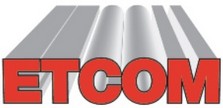What is an Extruded Thermoset Composite? ETCOM Inc. specializes in the extrusion of thermoset composite plastics. By definition, to extrude something means to force a material or substance through a shaped hole, orifice or die that has a specific design or profile producing a continuous length, whether it be a rod, tube, flat stock or – a specific profile. For example, when you squeeze a tube of toothpaste and it comes out onto your toothbrush you are, in fact, doing an extrusion process – simple as that!
There are two general families of plastics – Thermoplastics which is the group of plastics we are all the most familiar with in everyday life. It includes, but is not limited to – plastic cups, car interiors, toys, computers etc. There is another member of the plastics family which is called thermosetting plastics which can be found in billiard balls, pots and pan handles and the old distributer caps on trucks and cars as well as the old black telephones. Thermoplastics are subject to heat and can be formed or remolded by reapplying heat again and again. Thermosets, on the other hand, can only be heated and molded once and only once, which, as it turns out, is a good thing – especially in high heat applications – thermosets will not melt! Thermosets, once the material is cured (heated and molded – much like in the curing of concrete), the molecules cross-link like the rungs on a ladder. This part can no longer be melted, at any temperature. If the heat from a blow torch is focused on a thermoset part it will only char. It might make it red hot but it won’t melt it. This is a very unique characteristic of extruded thermoset materials or parts. In addition, just like concrete, thermoset plastics are also able to withstand very high compression forces without creep or drifting of the part material – it will maintain its shape. For example: Thermoset “S” Cam bushings on truck brake assembly applications can withstand the incredible pounding from pothole shocks even when they are hot, they will still maintain their shape integrity and performance characteristics.
Extrusion vs. Molding. In the standard molding of a cylinder there always has to be a slight taper or draft angle. This is required so the part can then be removed from the mold itself. This draft angle establishes a non-parallel condition on both the ID and OD of the part which is unsuitable for bushing applications. When extruding thermosets there is no draft angle or tapering needed on the OD or ID of any part which eliminates the problem of non-parallel surfaces or having to machine the parts afterwards.
We Extrude Thermoset Composite Materials. During our manufacturing process high pressures are obtained creating an increased density on a modular level as well as matrix uniformity of the part. Cross-linking occurs which was discuss earlier. The combination of high pressure and uniform heat during the manufacturing process results in a stronger more durable and high density part that can and will outlast all other plastic materials especially in bearing applications. In fact, extruded bushings outperform their molded counterparts (that have been machined straight) by a factor of 20%-30% on standard wear tests. There are many other advantages to consider using thermoset composites for your application. Please refer to our Etcom Products page on our website for further application details.
The Advantages:
1. Thermoset composites will not melt – at any heat. A blow torch will only char the surface but even then, they will not melt.
2. Thermoset composites will not cold flow away from pressure or shock loads. They are dimensionally stable even when they are hot and under load. They will withstand shock forces of over 200 G’s (200 times the force of gravity) when properly installed in adequate housings or bores
3. Thermoset composites are dimensionally more stable than thermoplastics especially in high temperature applications.
4. Thermoset composites once cured, are not affected by chemicals or solvents such as gasoline, diesel fuel, greases, oils, alcohol, lacquers, acetone, acids or caustic solutions.
5. Foreign debris such as grit, sand, and road grime are not easily embedded into the surfaces of thermoset parts due to their hardness.
6. Thermoset composites remain very slippery and have very low sliding friction at very high and very low temperatures.
7. Thermoset composites never require the use of grease for lubrication (see S-Cam Composite Bushing for more details) which helps avoid contamination by impurities such as fine dirt and sand, extending the life of the bearing considerably.
8. Extruded Thermoset Composite Materials have a much higher density due to the high pressures we use, resulting in greater cross linking.
There are many other characteristics and properties attributable to Extruded Thermoset Composite Materials which are not listed here. Please visit our Contact page and let us know what you are looking for or what your questions or applications might be and we will be happy to get back in touch with you with that information.

